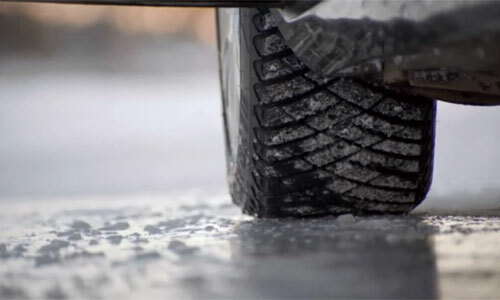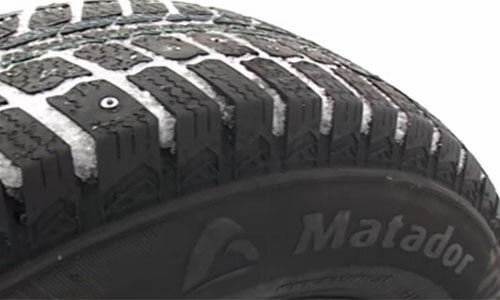The quality of rubber, as well as its compliance with operating conditions - is a key point on which road safety depends. With the arrival of winter, when weather conditions overboard the car become extreme, the urgency of this issue is significantly increasing.

Those motorists, who have not yet had to drive in the winter, may face the question: which winter tire should I choose? We will try to understand this issue.
How to distinguish winter tires from summer tires?
Before answering this question, it is necessary to understand what is the difference between winter rubber and summer tires. Many mistakenly believe that it is only in the figure and the height of the tread. In fact, the main role is played by the chemical composition of rubber, from which the tire is made.
Unfortunately, it has not yet been possible to create a rubber compound that would have the necessary ductility at any temperature. Rubber, oriented at a temperature above 10 degrees, "rustles" at low temperatures, and one that keeps plasticity in the cold, when it's warm, becomes too soft. That's why for each season you need to set your own type of tire.
You can not check the chemical composition at the time of purchase. All that a buyer can do is visually assess the type of tire tread. And, of course, pay attention to the marking of the tire. If you see the "M + S" badge, it means that you have winter tires( in translation this abbreviation stands for "Slush and Snow").
Choosing a reliable protector
An inexperienced driver can be surprised a lot by the incomprehensible variety in the sphere of winter wheels. Some manufacturers of winter rubber offer more than ten models of their products, differing in pattern and height of the tread.

But even under such conditions, the ideal rubber for road surfaces and weather conditions is just your region does not exist, you still have to look for a compromise. And one more thing: whatever model you choose, you still have to drive more carefully, reducing the maximum speed of movement of interest by 20 and increasing the distance to the vehicle in front.
When choosing a protector, it is necessary to remember that there are no universal products in this case. For each version of the pavement, there is an optimal kind of tire:
Asphalt hidden under a snow layer
If you often have to drive on loose or rolled snow, it is necessary that the tires of your car seem to bite into the snow. This will ensure you effective braking, no slippage and steady behavior of the car while driving. Choose a protector with individual elements in the form of diamonds or snowflakes up to 10 mm high with large gaps between them.
Road covered with "porridge" of snow, ice and reagents
This situation is typical for large cities, where utility services are sprinkled or watered roads with special chemical compounds. In this case, the protector should remove moisture from under the wheel. Such a tire can be recognized by a V-pattern and by a direction indicator of rotation( a large arrow on the side surface).
"European winter"( dry cleaned asphalt with occasional slushy areas)
In the CIS countries, this road can be seen extremely rarely, so this is rather a hypothetical option. For such conditions it is better to buy a winter tire with a directional type of tread and a high speed index.
Equal combination of all the above types of coating
Here the best solution is to buy a classic winter tire. It is characterized by wide longitudinal grooves, medium-sized transverse gaps, and also the height of the profile of the tread in the range of 7-8 mm. These tires can be directional, but this is not necessary. The performance characteristics of such tires, as well as of any universal element, are average. They are good for quiet deliberate movement in winter with the predominance of asphalt.
In addition to the described types, there is a relatively new type of tires with asymmetric tread, which is divided into longitudinal( external)( classic) and internal( off-road) parts. Unambiguously assess the merits of this design can only be experienced.
Spikes: Pros and Cons
There are many pitfalls in the application of studded tread. On the one hand, the thorns significantly improve the grip of the wheels with a road covered with ice or snow. But on the other hand - when hit on a clean asphalt, both wet and dry, the tire with the spikes "keeps" for the road even worse than the summer one.

For this reason, in some countries rubber with spikes is prohibited. To decide if you need a winter tire with spikes or without, you'll appreciate how often you have to ride on snow and ice. If this happens sporadically - do not risk contacting spikes. Moreover, modern winter tires often behave on the ice no worse than studded ones, which is due to the transverse lamellas, which motorists call "velcro" among themselves.
When the health of the driver depends on the reliability of the manufacturer
It is clear that even the most experienced driver is not able to thoroughly study all the parameters of the acquired tires up to their chemical composition. There is only one way to ensure the proper quality of the product - choose a well-known brand of winter tires. Strongly advise when buying a winter( and any other) tires do not try to save, preferring the questionable products of little-known manufacturers.
It's better to choose winter tires from PIRELLI, Scorpion Ice & Snow, Snowsport or GOODYEAR.On unpredictable domestic roads, you repeatedly mentally thank yourself for the right choice.
In conclusion, I would like to remind you that traffic safety is determined not by tires, but with what responsibility you take to driving. Remember: it's better to move slowly and lose a few seconds of life than to go fast, but lose life in a second. Good luck on the roads!



